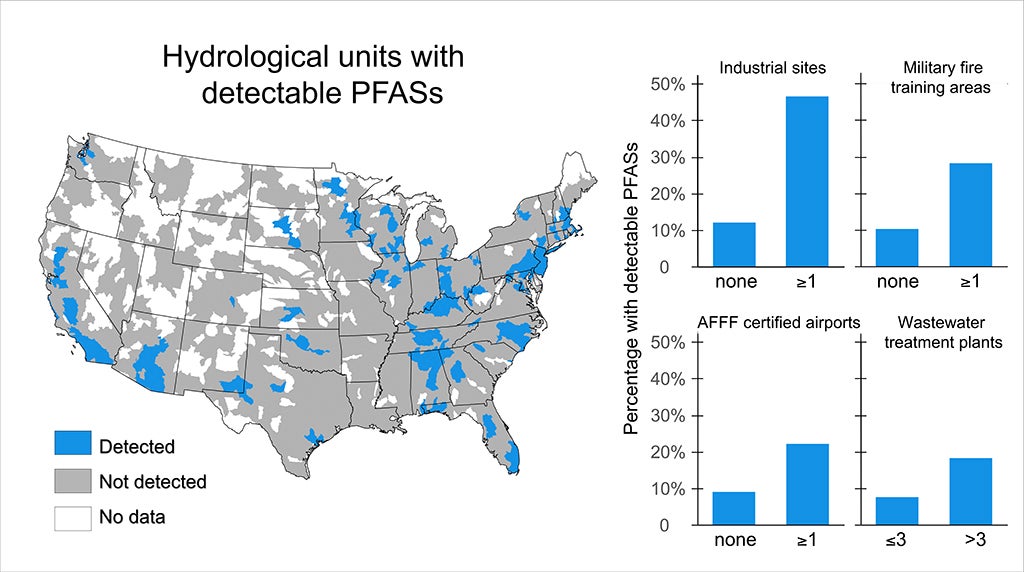Drinking water samples near industrial sites, military fire training areas, wastewater treatment plants have highest levels of fluorinated compounds
For immediate release: August 9, 2016
Boston, MA – Levels of a widely used class of industrial chemicals linked with cancer and other health problems—polyfluoroalkyl and perfluoroalkyl substances (PFASs)—exceed federally recommended safety levels in public drinking water supplies for six million people in the U.S., according to a new study led by researchers from Harvard T.H. Chan School of Public Health and the Harvard John A. Paulson School of Engineering and Applied Sciences (SEAS).
The study will be published August 9, 2016 in Environmental Science & Technology Letters.
“For many years, chemicals with unknown toxicities, such as PFASs, were allowed to be used and released to the environment, and we now have to face the severe consequences,” said lead author Xindi Hu, a doctoral student in the Department of Environmental Health at Harvard Chan School and Environmental Science and Engineering at SEAS. “In addition, the actual number of people exposed may be even higher than our study found, because government data for levels of these compounds in drinking water is lacking for almost a third of the U.S. population—about 100 million people.”
PFASs have been used over the past 60 years in industrial and commercial products ranging from food wrappers to clothing to pots and pans. They have been linked with cancer, hormone disruption, high cholesterol, and obesity. Although several major manufacturers have discontinued the use of some PFASs, the chemicals continue to persist in people and wildlife. Drinking water is one of the main routes through which people can be exposed.
The researchers looked at concentrations of six types of PFASs in drinking water supplies, using data from more than 36,000 water samples collected nationwide by the U.S. Environmental Protection Agency (EPA) from 2013–2015. They also looked at industrial sites that manufacture or use PFASs; at military fire training sites and civilian airports where fire-fighting foam containing PFASs is used; and at wastewater treatment plants. Discharges from these plants—which are unable to remove PFASs from wastewater by standard treatment methods—could contaminate groundwater. So could the sludge that the plants generate and which is frequently used as fertilizer.

Credit: Hu et al, Environmental Science & Technology Letters
http://pubs.acs.org/doi/pdf/10.1021/acs.estlett.6b00260
The study found that PFASs were detectable at the minimum reporting levels required by the EPA in 194 out of 4,864 water supplies in 33 states across the U.S. Drinking water from 13 states accounted for 75% of the detections, including, in order of frequency of detection, California, New Jersey, North Carolina, Alabama, Florida, Pennsylvania, Ohio, New York, Georgia, Minnesota, Arizona, Massachusetts, and Illinois.
Sixty-six of the public water supplies examined, serving six million people, had at least one water sample that measured at or above the EPA safety limit of 70 parts per trillion (ng/L) for two types of PFASs, perfluorooctanesulfonic acid (PFOS) and perfluorooctanoic acid (PFOA). Concentrations in some locations ranged as high as 349 ng/L for PFOA and 1,800 ng/L for PFOS.
The highest levels of PFASs were detected in watersheds near industrial sites, military bases, and wastewater treatment plants—all places where these chemicals may be used or found.
“These compounds are potent immunotoxicants in children and recent work suggests drinking water safety levels should be much lower than the provisional guidelines established by EPA,” said Elsie Sunderland, senior author of the study and associate professor in both the Harvard Chan School and SEAS.
Other Harvard Chan authors of the study included Philippe Grandjean and Courtney Carignan.
Funding for the study came from the Smith Family Foundation and a private donor.
“Detection of Poly- and Perfluoroalkyl Substances (PFASs) in U.S. Drinking Water Linked to Industrial Sites, Military Fire Training Areas, and Wastewater Treatment Plants,” Xindi C. Hu, David Q. Andrews, Andrew B. Lindstrom, Thomas A. Bruton, Laurel A. Schaider, Philippe Grandjean, Rainer Lohmann, Courtney C. Carignan, Arlene Blum, Simona A. Balan, Christopher P. Higgins, and Elsie M. Sunderland, Environmental Science & Technology Letters, online August 9, 2016, doi: 10.1021/acs.estlett.6b00260
Note: This release was updated on August 10 and August 11, 2016.
From the authors of the Environmental Science & Technology Letters study: We have mapped watersheds in the United States that have potentially high concentrations of PFASs based on U.S. EPA data. This does not mean that all drinking water supplies within the highlighted regions contain high PFAS concentrations, but that at least one sample from at least one water supply was reported to be at or above levels considered safe by the U.S. EPA between 2013 and 2015. However, no measurements have been made in many water supplies across the country. We recommend increased monitoring of these contaminants in our drinking water. For more information, please contact the U.S. EPA: Cathy Milbourn, Milbourn.cathy@Epa.gov, 202-564-7849 or Monica Lee, Lee.monica@Epa.gov, 202-564-0645.
PFASs and reduced immune response
Another Harvard Chan School study, led by Grandjean, adjunct professor of environmental health, published in Environmental Health Perspectives, also suggested negative health impacts of PFAS exposure. That study looked at a group of about 600 adolescents from the Faroe Islands, an island country off the coast of Denmark. Those exposed to PFASs at a young age had lower-than-expected levels of antibodies against diphtheria and tetanus, for which they had been immunized. The findings suggested that PFASs, which are known to interfere with immune function, may be involved in reducing the effectiveness of vaccines in children.
Funding for this study came from the National Institute of Environmental Health Sciences, NIH (ES012199); the U.S. Environmental Protection Agency (R830758); the Danish Council for Strategic Research (09-063094); and the as part of the environmental support program DANCEA (Danish Cooperation for Environment in the Arctic).
“Serum Vaccine Antibody Concentrations in Adolescents Exposed to Perfluorinated Compounds,” Philippe Grandjean, Carsten Heilmann, Pal Weihe, Flemming Nielsen, Ulla B. Mogensen, and Esben Budtz-Jørgensen, Environmental Health Perspectives, online August 9, 2016, doi: 10.1289/EHP275
Visit the Harvard Chan School website for the latest news, press releases, and multimedia offerings.
For more information:
Marge Dwyer
617.432.8416
mhdwyer@hsph.harvard.edu
photo: iStockphoto.com
###
Harvard T.H. Chan School of Public Health brings together dedicated experts from many disciplines to educate new generations of global health leaders and produce powerful ideas that improve the lives and health of people everywhere. As a community of leading scientists, educators, and students, we work together to take innovative ideas from the laboratory to people’s lives—not only making scientific breakthroughs, but also working to change individual behaviors, public policies, and health care practices. Each year, more than 400 faculty members at Harvard Chan School teach 1,000-plus full-time students from around the world and train thousands more through online and executive education courses. Founded in 1913 as the Harvard-MIT School of Health Officers, the School is recognized as America’s oldest professional training program in public health.
